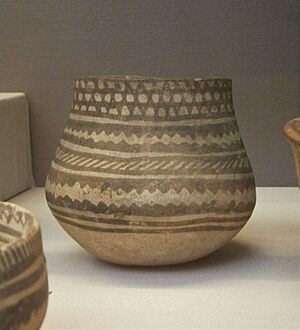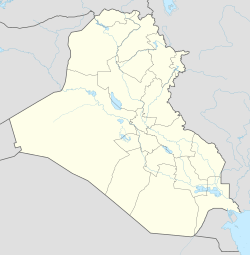Choga Mami facts for kids
|
Unknown Native Name
|
|
| Location | Diyala Province, Iraq |
|---|---|
| Region | Mandali region |
| Coordinates | 33°53′00″N 45°27′00″E / 33.883330°N 45.449990°E |
| Type | Settlement |
| History | |
| Material | Mud Brick |
| Founded | 5600 BC |
| Abandoned | 4800 BC |
| Site notes | |
| Excavation dates | 1967-1968 |
| Archaeologists | Joan and David Oates |
| Condition | In ruins |
Choga Mami is an ancient village site in eastern Iraq. It was part of the Samarra culture. This site is very important because it shows some of the earliest evidence of irrigation using canals. People here were using these canals around 6000 BCE.
The site is about 70 miles (110 kilometers) northeast of Baghdad. People lived here during different time periods. These included the Samarran culture and later the Ubaid period. The buildings were rectangular and made from mud bricks. There was even a guard tower at the village entrance.
The irrigation system helped the people grow crops like wheat, barley, and flax. They also raised animals such as cattle, sheep, and goats. Choga Mami helps us understand how ancient cultures in Mesopotamia were connected. It also shows how new ideas, like irrigation and different types of grain, spread.
Archaeologists found many interesting things at Choga Mami. These included painted pottery from the Samarran culture. They also found detailed clay figures of people.
Contents
Discovering Choga Mami's Past
Choga Mami is the largest ancient mound, called a tell, in the Mandali region. Archaeologists David and Joan Oates explored the site. They described it as a "low mound" about 200 meters long. The highest parts were 2 to 5 meters tall.
The oldest parts of the site date back to 4800 BCE. Findings suggest that Choga Mami had small village groups. These groups used small irrigated areas to grow wheat and barley. They also herded sheep, goats, and some cows. People hunted gazelles and other wild animals too.
They grew lentils and large peas. Pistachios were gathered from nearby areas. The people could grow plants and raise animals because of man-made irrigation channels. These channels ran along the northern side of the mound. They date back to the 6th millennium BCE.
A large canal from the end of the Samarran period was on the southwestern side. Some of these channels were over five kilometers long. Building such long channels would have needed many people working together. The newest canals found here are about 1,500 years old.
How Archaeologists Studied Choga Mami
Archaeologists Joan and David Oates led the dig at Choga Mami. Their first excavation season started in December 1967 and ended in February 1968. They chose Choga Mami because of its location in Iraq. This area was likely a busy travel route in ancient Mesopotamia.
During the dig, the team found many things. They uncovered mud brick rooms, all similar in size and neatly lined up. They also found pottery, tools, and many small clay figures. David Oates even found a jar with the broken remains of what seemed to be a baby burial. This led them to believe that Choga Mami was once a small town.
Ancient Buildings of Choga Mami
Excavations at Choga Mami have shown many layers of buildings. These layers date from the early 6th millennium BCE. A mud-brick tower stood at the entrance to the settlement. Archaeologists believe it was a watch tower. They found part of a ramp next to it.
The homes at Choga Mami were made from local mud bricks. They were rectangular, in the style of the Samarra culture. These homes were often built directly on top of older buildings. Most houses had two or three rows of small rooms. These rooms were on either side of a central hall. This layout is called a "tripartite plan." It was common in Mesopotamia for both homes and public buildings.
Many houses at Choga Mami had strong outer supports called buttresses. These supports were at the corners and where walls joined. The largest house found was 10 by 7 meters and had twelve rooms. Even when new building ideas came along, these buttresses were still used. By the end of the Samarran period, they were mostly just for decoration.
Pottery and Art from Choga Mami

The pottery found at Choga Mami was made with similar materials and styles as other Samarran pottery. Many pieces show detailed images of animals. This was a common feature of art from that time.
Archaeologists found both painted and unpainted pots. They also discovered clay beads and small figures. Most figures were standing male or female terracotta statues. Other figures looked like those from the later Ubaid period in southern Iraq.
These small baked clay figures often had hands at their waist. They were decorated with many details. Their body parts were often made to look bigger than normal. Many had eyes made of clay, wavy hairstyles, and beauty marks. These features were typical of pottery from the Mandali region. Few terracotta figures have been found whole. This is because they were often made from smaller pieces joined together. These joining points often broke over time.
See also
- Jawa Dam, Jordan
- Samarran culture
- Joan Oates
- David Oates



